
A dive to the past
By Mario Pereira, Luis Mota and Luis Quinta

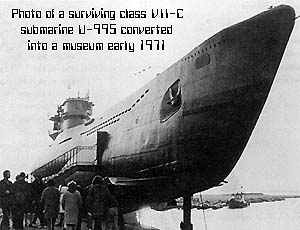  he he
 was built in the Vulcan shipyard in
Bremen-Vegesack, commisioned on May 3rd 1944 and launched on May 18th of the same year,
with her command delivered to captain-lieutenant Peter Ehrenreich Stever. was built in the Vulcan shipyard in
Bremen-Vegesack, commisioned on May 3rd 1944 and launched on May 18th of the same year,
with her command delivered to captain-lieutenant Peter Ehrenreich Stever.
She belongs to VII C class (combat sub) and she was, originally,
67m (221ft) long, 6.20m (20ft) high and 4.74m (15ft) waterline beam. She used two of four
engines (two diesel and two electric engines) that generated a power of 3200 hp with
maximum speed of 17.6 knots on surface and 750 hp with maximum speed of 7.6 knots when
submerged.
She displaced 769 tons on the surface and 871 when submerged. The
ship had a range of 8500 miles at 10 knots on surface, 130 miles at 2 knots submerged,
3250 miles at 17 knots on surface and 80 miles at 4 knots submerged. She could submerge to
a maximum depth between 150m (495ft) and 180m (594ft) with a minimum crash-dive time
between 25 and 30 seconds and she had the capacity to store 113.5 tons of fuel.
The sub was fitted with four torpedo launch tubes on the bow, two
on starboard side and two on portside, and a fifth on the stern (all 533mm), carrying a
total of 14 torpedos. She had also, outside the tower, anti-aircraft guns. These guns were
an automatic 37mm cannon and two twins 20mm machine guns.
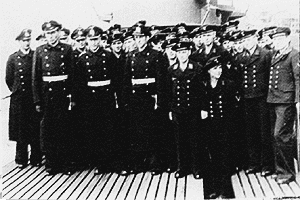 This submarine was
integrated on the 8th flotilla, where she worked first as an experimental and instruction
ship. On February 1945, because of the few remain U-boats still fighting, she was
transferred to the 11th flotilla. The mission, after sail from Bergen (Norway) as a combat
sub with full equipment, was to sail across the Iceland Strait to the Atlantic and
position herself on the entrance of the English Channel. This submarine was
integrated on the 8th flotilla, where she worked first as an experimental and instruction
ship. On February 1945, because of the few remain U-boats still fighting, she was
transferred to the 11th flotilla. The mission, after sail from Bergen (Norway) as a combat
sub with full equipment, was to sail across the Iceland Strait to the Atlantic and
position herself on the entrance of the English Channel.
The crew was composed by 45 men, four of which were officials -
commandant, first subordinate officer, second subordinate officer and the machine officer
- four sergeants and the 37 remaining were sailors. The age of the crew of the
 averaged between 18 and 25. averaged between 18 and 25.
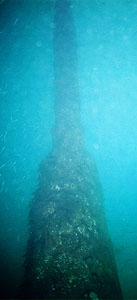 The U-boat was
intentionaly sunk on the dawn of June 3rd 1945 out of Cabo do Mundo near OPorto by order
of it's commander, the captain-lieutenant Stewer, after sailing without course through the
Atlantic for a period of one month (the Armistice was signed on May 8th 1945, precisely
one year after it's launch into the water and almost one month before it was sunk). The U-boat was
intentionaly sunk on the dawn of June 3rd 1945 out of Cabo do Mundo near OPorto by order
of it's commander, the captain-lieutenant Stewer, after sailing without course through the
Atlantic for a period of one month (the Armistice was signed on May 8th 1945, precisely
one year after it's launch into the water and almost one month before it was sunk).
In October 1973 a group of sport divers and local fishermen went
out to sea to find out what was the obstacle that take hold of all their fishing nets. It
was with some luck and happiness that they found that the obstacle was the famous german
submarine that sunk on our coast at the end of the World War II.
The sub rests since 1945 at 30m (100ft) on a sandy seabed, with
the stern completely silted up and lain about 45 degrees on her portside. The bow is
missing, existing only the four torpedos launch tubes, as well as the tower where all
anti-aircraft guns were.
The hull is dressed with little anemones, thousands of small
fishes, conger eels that are the biggest that can be found in these waters, huge
octopusses and the amazing colony of pink anemones descendant from the North Sea, These
are some of the natural attraction of this wreck. On the tower, divers can only see the
hard hull (made with 22mm solder rigid sheet metal), the periscope and the open hatchway.
Even in this state of deterioration, the
 is still clearly one of the best and more
interesting wreck dive sites of Portugal and the best in the north of our country. is still clearly one of the best and more
interesting wreck dive sites of Portugal and the best in the north of our country.
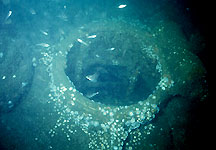 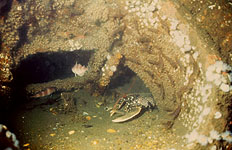
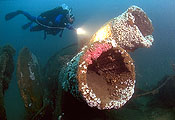
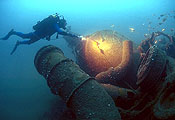
Only divers with some experience should do this dive, because at
30m it's already considered a deep dive, and the location is in the open sea, sometimes
with currents and less than perfect visibility.

THE INFORMATION ABOUT THIS
DIVE SITE WAS PROVIDED BY:
Thank you
for your visit!

© Mario Pereira, Luis Mota y Luis Quinta
|